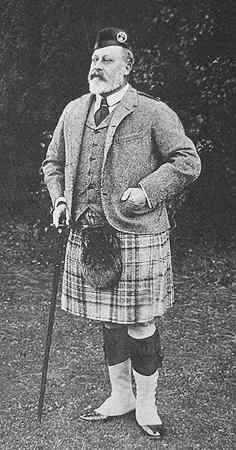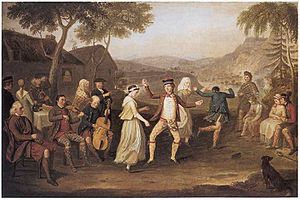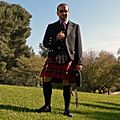Highland dress facts for kids
Highland dress is the traditional clothing from the Highlands and Isles of Scotland. It is famous for its use of tartan fabric. Tartan is also known as plaid in North America. This special clothing often includes specific shirts, jackets, and hats. People also wear clan badges and other items that show their family history.
Men's Highland dress usually features a kilt or trews (trousers) made from their clan's tartan. They might also wear a large tartan full plaid, a smaller fly plaid, or a short belted plaid. Many accessories go with this outfit. These can include a belt, a sporran (a small pouch), a sgian-dubh (a small knife), and special knee-socks called kilt hose. Other items are garters, kilt pins, and clan badges.
Women's Highland dress also uses clan tartan. A woman can choose her birth clan's tartan or her husband's clan's tartan if she is married. Traditionally, women and girls do not wear kilts. Instead, they might wear long tartan skirts. These are often paired with a matching blouse and vest. A tartan earasaid (a large shawl), a sash, or a tonnag (a smaller shawl) can also be worn. These are usually held in place with a brooch, sometimes with a clan badge.
Contents
Highland Dress Today
Highland dress is still very popular in Scotland today. People wear it for many different events. It can be worn casually for everyday activities. It is also worn for formal events like ceilidhs (traditional Scottish parties) and weddings.
The rules for how to wear Highland dress formally were mostly set during the Victorian era. These styles have not changed much since then. For example, the Prince Charlie and Argyll jackets look old-fashioned. They are based on military jackets from the Victorian age.
No matter how formal the occasion, the main part of Highland dress is always the tartan. It can be seen in a kilt, trews, arisaid, sash, or tonnag. In Scotland, tartans are officially recorded at the Scottish Register of Tartans. Most tartans belong to a specific clan or family group. However, some tartans are made for individuals or groups. There are also "district" or "national" tartans that do not belong to any particular family.
Long ago, men often carried weapons with their Highland dress. These included items like the dirk (a type of dagger). Today, because of knife laws, you will mostly see small sgian-dubhs. People also use sword-shaped kilt pins as decoration.
For shoes, both men and women might wear dance ghillies. These are soft, thin shoes mainly used for indoor wear and Scottish dancing. Ghillie brogues are thicker, more formal shoes. Both types of ghillies have laces that wrap around the ankle. This helps them stay on in muddy conditions. They also do not have tongues, so feet can dry faster in Scotland's damp weather.
Wearing Highland Dress for Formal Events
Highland dress can be worn for very formal daytime events. This style is similar to what is called "morning dress" in other countries.
Men's formal day wear usually includes:
- A plain wool or barathea jacket in black, charcoal, or tweed. Styles include Argyll, Crail, or Braemar jackets.
- A belt and buckle, or a waistcoat (vest) in a matching or tartan material.
- A kilt.
- A white shirt with a turndown collar and French cuffs.
- A long tie in one color or a striped style.
- Black brogues (shoes).
- Tartan, argyle, or dark colored socks.
- Flashes or garter ties to hold up the socks.
- A day or horse hair sporran.
- A day-dress sgian-dubh, which is simpler than those for evening wear.
Wearing Highland Dress for Evening Events
For very formal evening events, like "white tie" occasions, Highland dress is also worn.
Men's formal evening wear includes:
- A formal kilt doublet (jacket) made of barathea or velvet. Velvet is considered more formal.
- A waistcoat (vest) in white, tartan, or red.
- A kilt with a formal kilt pin.
- A white formal shirt.
- A white lace jabot (a frilly neck decoration). Sometimes a black bow tie is worn instead.
- Black formal shoes or buckle brogues.
- Tartan or patterned kilt socks.
- Silk garter flashes or garter ties.
- A fancy sporran with a silver chain belt.
- A black, silver-mounted, and jeweled sgian-dubh.
- A Highland bonnet (hat) with a crest badge (worn only outdoors).
- A short belted plaid with a silver plaid brooch (optional).
- A Scottish dirk (optional).
Semi-Formal Highland Dress
There are also semi-formal versions of Highland dress for both day and evening events.
For semi-formal day wear, men typically wear:
- A black or charcoal semi-formal kilt jacket.
- A waistcoat in black, grey, or tartan.
- A kilt.
- A white shirt with a turndown collar and French cuffs.
- A tie in a single color.
- Black brogues.
- Tartan, argyle, or dark socks.
- Flashes or garter ties.
- A day-dress sporran (often black leather).
- A day-dress sgian-dubh.
For semi-formal evening wear, often called "black tie," men wear:
- A black or colored barathea jacket with silver buttons. Popular styles include the Regulation doublet or Prince Charlie jacket.
- A black waistcoat.
- A kilt.
- A white shirt with a turndown collar.
- A black bow tie.
- Evening dress brogues.
- Tartan or patterned kilt socks.
- Silk flashes or garter ties.
- A dress sporran with a silver chain.
- A black, silver-mounted sgian dubh.
- A Highland bonnet with a crest badge (worn only outdoors).
Highland Dress in History
In 1618, a poet from London named John Taylor wrote about Scottish nobles and their helpers. He saw them dressed for hunting in Braemar. Everyone, rich or poor, dressed the same way for hunting. They wore tartan stockings and jackets. They had twisted straw garters and a fine plaid mantle (cloak) over their shoulders. They also wore knotted handkerchiefs around their necks and blue caps. Taylor said the tartan was "warm stuff of diverse colours."
Later, in the late 1600s, Martin Martin described traditional women's clothing in the Western Islands. He wrote about the earasaid with its brooches and buckles.
In 1689, an English chaplain named Thomas Morer described Highland men's clothing. They wore plaids about 7 to 8 yards (about 6 to 7 meters) long. These plaids covered them from the neck to the knees, leaving one arm free. Underneath, they wore a waistcoat or a shirt. These were called "belted plaids." Their stockings were made of the same fabric as the plaid. Their shoes were called "brocks" (brogues). Their hats were blue or dark colored. Morer noted that richer men had finer fabrics.
People in the Scottish Lowlands and Border areas dressed more like the English. However, both men and women there also used a plaid as a cloak. Lowland women wrapped their plaids over their heads like hoods. Lowland and Border men wore a checkered maud (plaid) wrapped around their upper body. This maud became a key part of Border dress. Famous Border Scots like Walter Scott and James Hogg wore it. Even Robert Burns is shown wearing a maud in his portraits.
Images for kids
-
A woman wearing an earasaid and the typical hairstyle of a married woman, with a child in Matheson tartan (1845).
-
A member of Clan MacNeacail, from The Clans of the Scottish Highlands, wearing a tonnag R. R. McIan (1845).
-
Portrait by Henry Raeburn of Alexander Ranaldson MacDonell of Glengarry in 1812.
-
Piper playing the Great Highland Bagpipes in traditional Scottish piper's uniform (2010).















